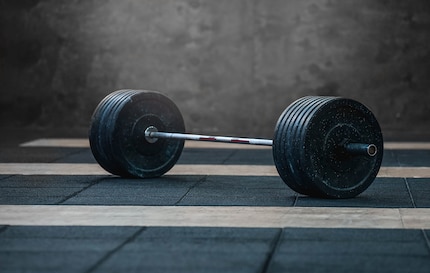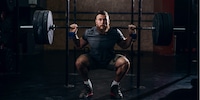
Background information
How long a break is needed between sets during strength training?
by Claudio Viecelli

Big weights are supposed to encourage muscle growth. Which is exactly why many work out according to the motto «Go heavy or go home,» when you should actually «Go smart or go home.»
What influence does your chosen weight or intensity have on muscle mass? This is one of the basic questions in strength training. Therefore, let me first define both terms to offer some clarity. Load in strength training refers to the mass or weight of an object, such as a dumbbell, in kilograms. Intensity is usually defined as a percentage of maximum voluntary force (% 1-repetition maximum (1-RM)). As the name suggests, 1-RM represents the mass with which you can completely perform a given exercise exactly once, but not a second time. Accordingly, 2-RM represents the mass with which you can master the exercise twice. 3-RM represents 3 repetitions, and so on. Combined with the mass that was successfully handled at 1-RM, you can now give the intensity as a percentage. So 60% 1-RM corresponds to 60% of the mass successfully moved at 1-RM. If 1-RM for a biceps curl is 20 kg, 60% 1-RM would therefore correspond to 12 kg.
Now, what effect does your chosen load or intensity have on muscle growth or energy use? High training intensities (70-80% 1-RM) are still recommended to stimulate muscle growth. This is because mechanical stress on muscle fibres – caused by external loads, such as the mass of a dumbbell – is a primary mechanism for stimulating muscle growth. How high must this mechanical stress effectively be?

A research group around Kumar et al. [1] investigated the relationship between muscular protein buildup and exercise intensity using a study design in which the work done was equal in two test groups. Strength training consisted of dominant leg extension exercises from 20% to 90% 1-RM in 25 young (24 ± 6 years) and older (70 ± 5 years) men with identical body mass indexes (24 ±). In order to average their workouts, participants were divided into groups:
Workouts were done with a two-minute break between each set. Protein buildup was measured 1, 2, and 4 hours after exercise. Kumar and colleagues found that intensity and protein buildup were related to each other in a sigmoid or gooseneck function (a model for describing growth processes, which looks like an S. Hence why it’s also called an S-function). Intensities greater than 60% 1-RM didn’t result in any further significant increase in protein breakdown. This means that increasing the intensity of your training doesn’t further increase protein buildup and thus muscle growth.
In a study by Schoenfeld et al. [2], men with experience in strength training were divided into two groups, with both groups completing the same amount of training. One group trained according to a bodybuilding protocol (3 x approx. 10 repetitions) while the other followed a powerlifting regimen (7 x approx. 3 repetitions). The training was carried out three times a week over eight weeks. Bicep muscle cross-sections increased similarly in both groups. Increases in strength were higher in the powerlifting group due to the specificity of the test. However, it’s interesting to note the authors’ statement, which says that participants in the powerlifting group showed signs of overtraining and joint problems at the end of the study, while no such symptoms were observed in the bodybuilding group.
Note as well that in both studies, exercise was not performed until complete muscle failure. External mechanical work was held constant between training intensities. The question now arises, what happens when you work out until muscle failure? What influence does the load and/or intensity have there specifically on muscle growth?

Mitchell et al. [3] showed that, in untrained men (21 ± 1 years), different exercise intensities (i.e. 30% versus 80% 1-RM) can be used to grow quadriceps (anterior thigh muscle) muscles when exercised until muscle failure. Here, the researchers randomly assigned participants’ legs to two of three regimens that differed based on training intensity or volume. These regimens were composed as follows:
Participants trained their quadriceps using knee extensions three times a week for ten weeks. Muscle volume increased significantly in all groups. Any increase in strength following the study didn’t differ between the 80% 1-RM groups and the 30% 1-RM group.
In trained men, Morton et al. [4] showed that load has no effect on muscle growth or increases in strength, provided training is done until muscle failure. 49 fit men (23 ± 1 years) engaged in a full-body workout for twelve weeks. Participants were randomly assigned to a group with higher or lower training intensity. On average, they trained between 30-50% or 75-90% 1-RM and required between 20-25 or 8-12 repetitions per set until muscle failure. The strength and growth of muscle fibres increased significantly after twelve weeks in both groups.
The belief that heavier dumbbells lead to greater muscle growth is still strongly held. But this is a fallacy. If not exercised to complete muscle failure, loads or intensities greater than 60% 1-RM don’t further stimulate muscle growth. However, if trained to muscle failure, studies in both untrained and trained men show that external load or training intensity plays only a minor role, while intensities between 30-90% 1-RM are the way to go.
Another aspect to consider is biomechanical joint stress, which is greater at higher loads or intensities. Therefore, the best way to train is with lower to moderate loads or intensity until complete exhaustion.
Your new workout motto should be: «Train smart or go home».

Background information
by Claudio Viecelli

Background information
by Claudio Viecelli

Background information
by Claudio Viecelli